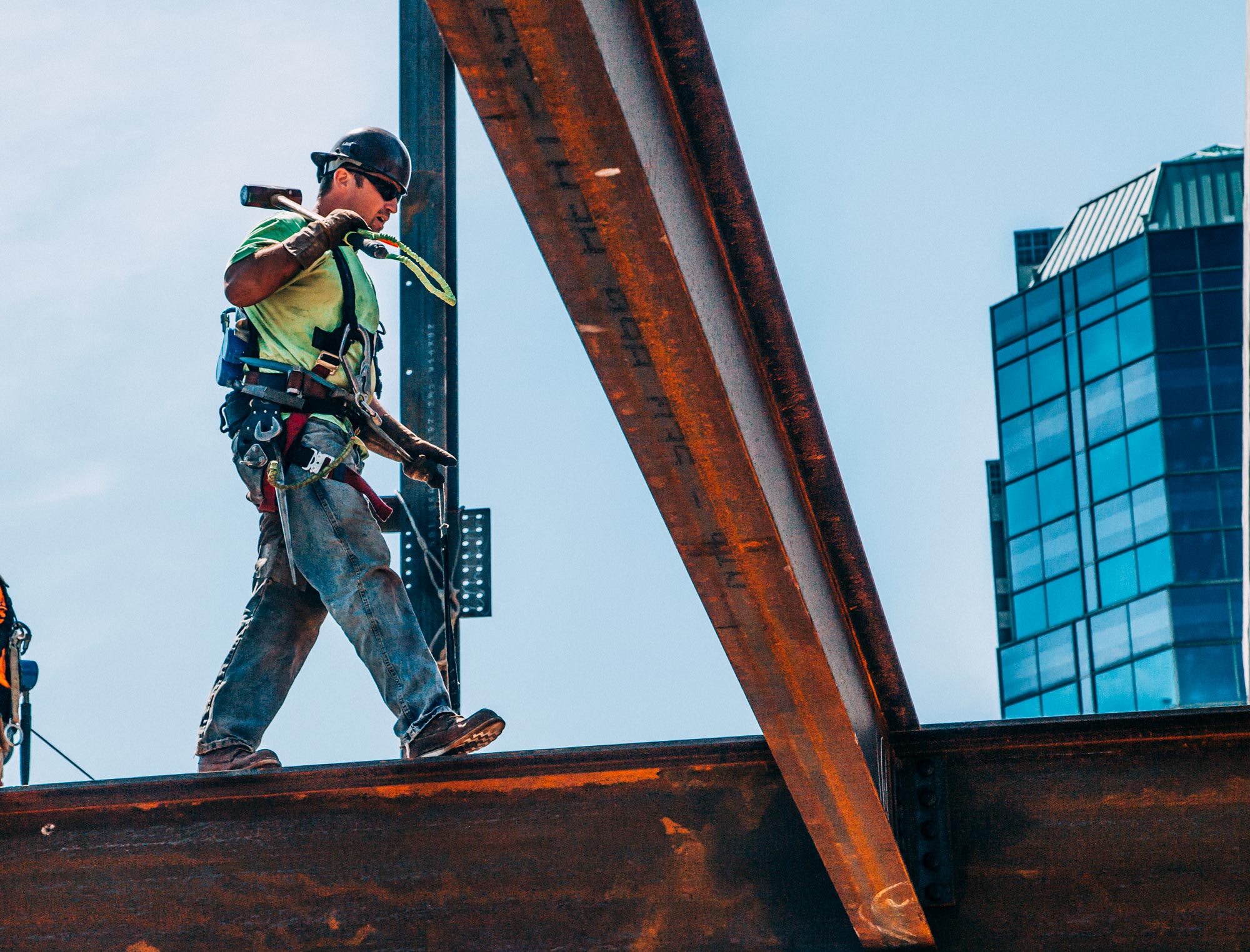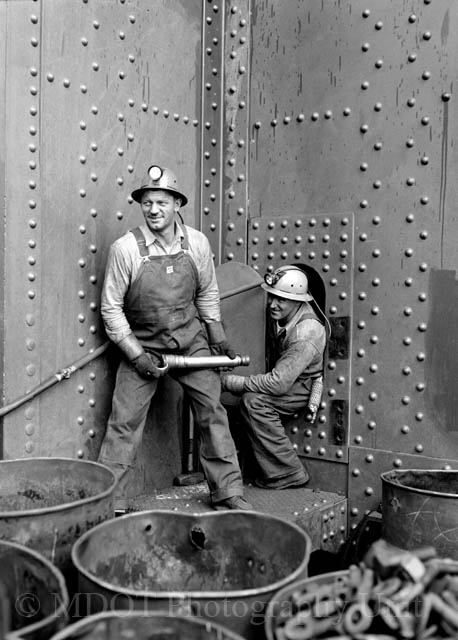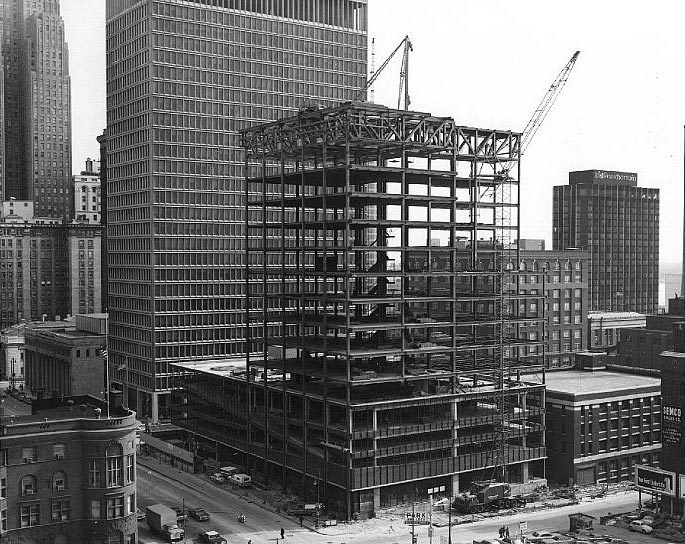About us

Since our founding in 1938, GLFEA has been a vocal advocate of the steel construction industry in Michigan.

GLFEA promotes steel, the steel industry and union construction to business owners, developers, architects, engineers, the steel industry, and the media.

Officers
President, Great Lakes Fabricators & Erectors Association
John Wozniak
Vice-President, Great Lakes Fabricators & Erectors Association
Joe Leslie
Secretary, Great Lakes Fabricators & Erectors Association
Kenneth Hollowell
Treasurer, Great Lakes Fabricators & Erectors Association
Executive Director
Directors
Active Past Presidents
Our History

1930’s
- 1930: The Detroit-Windsor Tunnel is the second busiest crossing between the United States and Canada after the nearby Ambassador Bridge. About 28,000 vehicles use the tunnel each day. It spans 5,160 feet (just short of a mile), and at its lowest point, the two-lane roadway is 75 feet below the river surface.
- 1937: Flint Sit-Down Strike ended with official recognition of the United Auto Workers by General Motors.
- 1938: On April 7 the Sheet & Metal Erectors Association was incorporated, the precursor to Great Lakes Fabricators & Erectors Association.
- 1938: The Blue Water Bridge is a twin-span international bridge spanning the St. Clair River that links Port Huron to Point Edward, Ontario. The first bridge is a cantilever truss with a total length of 6,178 feet, and was opened to traffic on October 10, 1938. The second three-lane bridge, just south of the first bridge, opened on July 22, 1997. It is a continuous tied arch with a total length of 6,109 feet. Together, the two bridges are one of the busiest transportation arteries between the United States and Canada.

1940’s
- 1942-45: World War II brought tremendous industrial activity to the Detroit/Metro area. From 1942 to 1945, production of commercial automobiles ceased entirely, as factories were used instead to construct M5 tanks, jeeps, and B-24 bombers for the Allies. The Guardian Building was converted into a control center for wartime production. The city’s major contribution to the Allied war effort earned it the nickname “The Arsenal of Democracy.”
- 1947: Detroit Metropolitan Wayne County Airport: Between 1947 and 1950, county officials expanded the small Wayne County Airport to become Detroit’s primary airport. The airport was renamed Detroit-Wayne Major Airport in 1947 and over the next three years expanded in size threefold as three more runways were built.

1950’s
- 1957: The Mackinac Bridge The Five-mile long bridge opened on November 1, 1957. A year later, the bridge was formally dedicated as the world’s longest suspension bridge between anchorages. At 8,614 feet, the Mackinac Bridge is the longest suspension bridge.
- 1959: On March 4, 1959 the Associated Steel Fabricators of Detroit, Inc.was founded. Eventually, this organization merged into GLFEA

1960’s
- 1960: Cobo Center, originally known as Cobo Hall, is a major convention center situated along Jefferson Ave. in downtown Detroit. Expanded in 1989, the present 2,400,000 sq ft (223,000 m2) complex contains 700,000 sq ft (65,000 m2) of exhibition space. Construction to update and further expand the center’s exhibition space to 866,000 sq ft (80,500 m2) may begin September 1, 2009. The center is the home of the North American International Auto Show or NAIAS, which is hosts each January.
- 1965: The Detroit Riverside Hotel (Originally known as The Pontchartrain), was constructed in 1965 to a height of 25 floors (245 feet). It contains 367 rooms, and is used as a hotel, restaurant, and fitness center. The hotel is built on the same exact site as Fort Pontchartrain (for which it was originally named), Detroit’s first permanent European settlement, built in 1701, which later became known as Fort Detroit. In 2007, the hotel underwent a major renovation.
- 1967: Great Lakes Fabricators and Erectors (GLFEA) became incorporated on February 28, 1967.

1970’s
- 1975: The Pontiac Silverdome was built at a cost of $55.7 million, and seated over 80,000 people. It contained 102 luxury suites and 7,384 club seats.
- 1976: The Renaissance Center (also known as the GM Renaissance Center and nicknamed the RenCen) is a group of seven interconnected skyscrapers in Downtown Detroit. Located on the International Riverfront. The first tower of the Renaissance Center opened on July 1, 1976, and in 1996, General Motors purchased the complex and moved its world headquarters here.
- 1979: The Joe Louis Arena, nicknamed The Joe and JLA is a hockey arena located at 600 Civic Center Drive in Detroit. It is the home of the Detroit Red Wings. Completed in 1979 at a cost of $57 million, Joe Louis Arena is named after boxer and former heavyweight champion Joe Louis, who grew up in Detroit. It is also one of the oldest venues in the NHL.

1980’s
- 1987: The elevated Detroit People Mover transit line, began operation with a stop at the Renaissance Center. It is a 2.9-mile automated people mover system which operates on a single-track, one-way loop through the central business district of downtown Detroit. As of 2008, the system moves about 7,500 people per day, about 2.5 percent of its capacity of 288,000.
- 1988: The Palace of Auburn Hills, often referred to simply as The Palace, is a sports and entertainment venue in Auburn Hills, Michigan. Opened in 1988, it is the home of the Detroit Pistons of the NBA. The Palace of Auburn Hills has a seating capacity of 22,076, the largest in the NBA. It is also a very popular venue for large concerts.

1990’s
- 1996: A state referendum paved the way for three Detroit casinos — MGM Grand Detroit, Motor City Casino and Greektown Casino.

2000’s
- 2000: Comerica Park: Groundbreaking for a new ballpark to replace Tiger Stadium for the Detroit Tigers was held on October 29, 1997 and the new stadium was opened to the public in 2000. The first game at Comerica Park was held on Tuesday, April 11, 2000 with 39,168 spectators attending. Comerica Park primarily serves as the home ballpark for the Detroit Tigers, who moved to the venue from Tiger Stadium in 2000. In 2005, Comerica Park hosted the 76th MLB All-Star Game, the first to be played in Detroit since 1971.
- 2002: Ford Field is an indoor football stadium located in Detroit that is the current home field of the NFL’s Detroit Lions. It regularly seats 65,000, though it is expandable up to 70,000 for football and 80,000 for basketball. The $430 million project incorporates a six-story former Hudson’s warehouse, which had stood since the 1920s. Unlike most indoor stadiums, Ford Field allows a large amount of natural light to reach the FieldTurf field, thanks to immense skylights and large glass windows at the open corners. The windows along the ceiling are frosted to mimic the automotive factories that are prevalent in Metro Detroit.
- 2002: The McNamara Terminal (Part of the Detroit Metropolitan Wayne County Airport), opened on February 25, 2002. It was the replacement for the aged Davey Terminal, which was the principal hub for Northwest Airlines until its closing in 2002. A Westin hotel is directly connected to the terminal. Additionally, overnight guests at the hotel who are not flying can obtain a pass to enter the concourses to visit shops and restaurants.
- 2003: Compuware World Headquarters, located at One Campus Martius, in downtown Detroit, opens for business. It stands at 18 floors in height, 16 above-ground, and 2 below-ground, and has 1,000,000 square feet of office space. The high-rise is used as an office building, a restaurant, retail space for Compuware, and has a fitness center inside, as well as an atrium.
- 2004: Campus Martius Park is a re-established park in downtown Detroit, which anchors the Campus Martius neighborhood and office district. It is where the “point of origin” of Detroit’s coordinate system is located. Seven miles north of this point is 7 Mile Road; eight miles north is 8 Mile Road, and so on. The 1.2 acre park is located at the intersection of Woodward Avenue and Michigan Avenue. The original park was lost in the 1900s as the city’s downtown was reconfigured to accommodate increased vehicular traffic. It includes two stages, sculptures, public spaces and a seasonal ice skating rink.
- 2008: Detroit Metropolitan Wayne County Airport: The North Terminal is the replacement for the aged Berry and Smith Terminals.
Industry Links
American Institute of Architects, Michigan Chapter www.aiami.com
American Institute of Steel Construction www.aisc.org
American Welding Society www.aws.org
American Society for Testing & Materials www.astm.org
American National Standards Institute www.ansi.org
Detroit Regional Chamber www.detroitchamber.com
IMPACT (Ironworker Management Progressive Action Cooperative Trust) www.impact-net.org
International Union of Operating Engineers www.iuoe.org
Ironworkers Local 25 www.ironworkers25.org
Ironworkers Local 340 www.ironworkerslocal340.org
International Association of Bridge, Structural, Ornamental and Reinforcing Iron Workers www.ironworkers.org
Management and Unions Serving Together www.mustonline.org
Michigan Department of Energy, Labor and Economic Growth (DLEG) www.michigan.gov/dleg
Michigan Secretary of State www.michigan.gov/sos
Michigan Society of Professional Engineers www.michiganspe.org
National Coordinating Committee for Multi-Employer Plans (NCCMP) www.nccmp.org
National Maintenance Agreements Policy Committee, Inc (NMAPC) www.nmapc.org
Operating Engineers Local 324 www.iuoe324.org
Steel Joist Institute www.steeljoist.org
TAUC – The Association of Union Constructors www.tauc.org
U.S. House of Representatives www.house.gov
U.S. Occupational Safety & Health Administration www.osha.gov
U.S. Senate www.senate.gov
Unions
International Association of Bridge, Structural, Ornamental and Reinforcing Iron Workers
1750 New York Avenue, N.W., #400
Washington, DC 20006
Ph: 202.383.4800
Fx: 202.638.4856
Web site: www.ironworkers.org
Iron Workers Local 25
25150 Trans X Drive
P.O. Box 965
Novi, Michigan 48176-0965
Ph: 248.344.9494
Fx: 248.344.4851
Contact: Jack O’Donnell
Web site: www.ironworkers25.org
Iron Workers Local 25 Training Center
50490 W. Pontiac Trail
Wixom, MI 48393
Ph: 248.960.2130
Fx: 248.960.0980
Contact: Kevin McDonell
Iron Workers Local 340
510 E. Columbia Ave
Battle Creek, MI 49014
Ph: 269.962.8511
Fx: 269.962.1485
Contact: Matt Schabes
Web site: www.ironworkerslocal340.org
International Union of Operating Engineers Local 324
500 Hulet Drive
Bloomfield Township, MI 48302
Ph: 734.462.3660
Fx: 734.462.4830
Contact: Doug Stockwell
Web site: www.iuoe324.org
Operating Engineers Local 324 Journeymen & Apprenticeship Training Fund Inc. Training Center
275 East Highland Rd. (M-59)
Howell, Michigan 48843
Ph: 888.256.9610
Ph: 517.546.9610
Fx: 517.546.9793
Contact: Lee Graham
Web site: www.benesysinc.com/benefit/oe324jatf.asp
Education Resources
Today, a two-story, reusable, steel-frame, training structure is available to give apprentices the opportunity to learn different connector technologies and safety methods in a controlled environment. Hands-on training, unlike any other in the country, is now available to the industry and, as methods and technologies change, this platform will carry our apprenticeship program into the next century.
The Skills Development Frame is used in the Iron Worker’s Apprenticeship Program. It was donated by the Great Lakes Fabricators & Erectors Association Industry Promotion & Improvement Fund. On-the-job training is what iron worker apprenticeships are all about. The difficulty has been safely mastering the variety of techniques needed throughout the industry. Until now, no one construction site could provide the opportunity. That has been changed by the GLFEA Industry Promotion & Improvement Fund.
Since 1938, GLFEA has been serving the steel erection and fabrication industry and currently represents approximately 50 firms in southeastern Michigan. For more information regarding GLFEA or the Skills Development Frame, please contact GLFEA by email at hello@glfea.org.
Training Videos
There are many training videos available to you from GLFEA.
